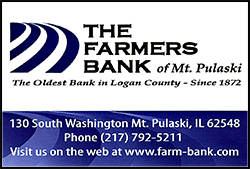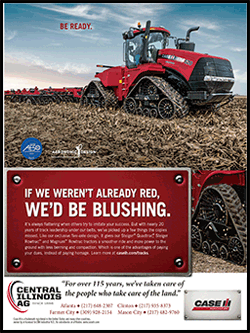|
It is the borrower’s responsibility to alert FSA to
any of the following:
- Any proposed or significant changes in the farming
operation;
- Any significant changes to family income or expenses;
- The development of problem situations;
Any losses or proposed significant changes in security.
- In addition, if a farm loan borrower cannot make
payments to suppliers, other creditors, or FSA on time,
contact your farm loan staff immediately to discuss loan
servicing options. For more information on FSA farm loan
programs, visit
www.fsa.usda.gov.
Special Accommodations
Special accommodations will be made upon request for
individuals with disabilities, vision impairment or hearing
impairment. If accommodations are required, individuals
should contact your local county FSA office directly or by
phone.
Census of Agriculture Countdown Begins for America’s
Farmers and Ranchers
America’s farmers and ranchers will soon have the
opportunity to strongly represent agriculture in their
communities and industry by taking part in the 2017 Census
of Agriculture. Conducted every five years by the U.S.
Department of Agriculture’s (USDA) National Agricultural
Statistics Service (NASS), the census, to be mailed at the
end of this year, is a complete count of all U.S. farms,
ranches, and those who operate them.

The Census of Agriculture highlights land use and ownership,
operator characteristics, production practices, income and
expenditures, and other topics. The 2012 Census of
Agriculture revealed that over three million farmers
operated more than two million farms, spanning over 914
million acres. This was a four percent decrease in the
number of U.S. farms from the previous census in 2007.
However, agriculture sales, income, and expenses increased
between 2007 and 2012. This telling information and
thousands of other agriculture statistics are a direct
result of responses to the Census of Agriculture.
Producers who are new to farming or did not receive a Census
of Agriculture in 2012 still have time to sign up to receive
the 2017 Census of Agriculture report form by visiting
www.agcensus.usda.gov and clicking on the ‘Make Sure You Are
Counted’ button through June. NASS defines a farm as any
place from which $1,000 or more of agricultural products
were produced and sold, or normally would have been sold,
during the census year (2017).
2017 Acreage Reporting Dates
In order to comply with FSA program eligibility
requirements, all producers are encouraged to visit their
local FSA office to file an accurate crop certification
report by the applicable deadline.
Acreage reporting dates vary by crop and by county so please
contact your local FSA office for a list of county-specific
deadlines.

The following exceptions apply to acreage reporting dates:
- If the crop has not been planted by the applicable
acreage reporting date, then the acreage must be
reported no later than 15 calendar days after planting
is completed.
- If a producer acquires additional acreage after the
applicable acreage reporting date, then the acreage must
be reported no later than 30 calendars days after
purchase or acquiring the lease. Appropriate
documentation must be provided to the county office.
- If a perennial forage crop is reported with the
intended use of “left standing” or “seed”, then the
acreage must be reported by July 15th. Noninsured Crop
Disaster Assistance Program (NAP) policy holders should
note that the acreage reporting date for NAP covered
crops is the earlier of the applicable dates or 15
calendar days before grazing or harvesting of the crop
begins. For questions regarding crop certification and
crop loss reports, please contact your local FSA office.
The following 2017 acreage reporting dates are
applicable for Illinois:
- September 30, 2016 aquaculture, Christmas trees,
turfgrass sod, floriculture
- December 15, 2016 fall seeded small grains,
canola, and perennial forage
- January 2, 2017 honey
- January 15, 2017 apples, asparagus, blueberries,
caneberries, cherries, grapes, nectarines, peaches,
pears, plums, strawberries, other perennial crops
- June 15, 2017 cucumbers (planted 5/1 – 5/31)
- July 15, 2017 All other spring and summer
planted crops
- August 15, 2017 cabbage (planted 6/1 – 7/20)
- September 15, 2017 cucumbers (planted 6/1 –
8/15)
Preauthorized Debit Available for Farm Loan
Borrowers
USDA Farm Service Agency (FSA) has implemented
pre-authorized debit (PAD) for Farm Loan Program (FLP)
borrowers. PAD is a voluntary and alternative method
for making weekly, bi-weekly, monthly, quarterly,
semi-annual or annual payments on loans.

PAD payments are pre authorized transactions that
allow the National Financial and Accounting
Operations Center (NFAOC) to electronically collect
loan payments from a customer’s account at a
financial institution.
PAD may be useful for borrowers who use nonfarm
income from regular wages or salary to make payments
on loans or adjustment offers or for payments from
seasonal produce stands. PAD can only be established
for future payments.
To request PAD, customers, along with their
financial institution, must fill out form RD
3550-28. This form has no expiration date, but a
separate form RD 3550-28 must be completed for each
loan to which payments are to be applied. A fillable
form can be accessed on the USDA Rural Development
(RD) website at http://www.rd.usda.gov/publications/regulations-guidelines.
Click forms and search for “Form 3550-28.”
If you have a “filter” on the account at your
financial institution, you will need to provide the
financial institution with the following
information: Origination ID: 1220040804, Agency
Name: USDA RD DCFO.
PAD is offered by FSA at no cost. Check with your
financial institution to discuss any potential cost.
Preauthorized debit has no expiration date, but you
can cancel at any time by submitting a written
request to your local FSA office. If a preauthorized
debit agreement receives three payment rejections
within a three month period, the preauthorized debt
agreement will be cancelled by FSA. The payment
amount and due date of your loan is not affected by
a cancellation of preauthorized debit. You are
responsible to ensure your full payment is made by
the due date.
For more information about PAD, contact your local
FSA office. To find a local FSA office, visit
http://offices.usda.gov
Adjusted Gross Income Requirements
The average adjusted gross income (AGI) limitation
for commodity and disaster programs under the 2014
Farm Bill was changed to a $900,000 limitation from
all income sources. A person or legal entity, other
than a joint venture or general partnership, is
eligible to receive, directly or indirectly, certain
program payments or benefits if the average adjusted
gross income of the person or legal entity falls
below the $900,000 threshold for the three taxable
years preceding the most immediately preceding
complete taxable year. However, the AGI limitation
for conservation programs may be waived on a
case-by-case basis if it is determined that
environmentally sensitive land of special
significance would be protected.

Signature Policy
Using the correct signature when doing business with
FSA can save time and prevent a delay in program
benefits. The following are FSA signature
guidelines:
- A married woman shall sign her given name:
Mrs. Mary Doe, not Mrs. John Doe
- For a minor, FSA requires the minor's
signature and one from an eligible parent
Note, by signing the applicable document, the
parent is liable for actions of the minor and
may be liable for refunds, liquidated damages,
etc.
When signing on one’s behalf the signature must
agree with the name typed or printed on the
form, or be a variation that does not cause the
name and signature to be in disagreement.
Example - John W. Smith is on the form. The
signature may be John W. Smith or J.W. Smith or
J. Smith. Or Mary J.
Smith may be signed as Mrs. Mary Joe Smith, M.J.
Smith, Mary Smith, etc.
FAXED signatures will be accepted for certain
forms and other documents provided the
acceptable program forms are approved for FAXED
signatures. Producers are responsible for the
successful transmission and receipt of FAXED
information.
Spouses may sign documents on behalf of each
other for FSA and CCC programs in which either
has an interest, unless written notification
denying a spouse this authority has been
provided to the county office.
Spouses shall not sign on behalf of each other
as an authorized signatory for partnerships,
joint ventures, corporations or other similar
entities.
MAL and LDP Policy
The Agricultural Act of 2014 authorized
2014-2018 crop year Marketing Assistance Loans (MALs)
and Loan Deficiency Payments (LDPs), with a few
minor policy changes.
Among the changes, farm-stored MAL collateral
transferred to warehouse storage will retain the
original loan rate, be allowed to transfer only
the outstanding farm-stored quantity with no
additional quantity allowed and will no longer
require producers to have a paid for measurement
service when moving or commingling loan
collateral.
FSA is now accepting requests for 2016 MALs and
LDPs for all eligible commodities after harvest.
Requests for loans and LDPs shall be made on or
before the final availability date for the
respective commodities. May 31 is the final loan
availability date for Corn, Dry Peas, Grain
Sorghum, Lentils, Mustard Seed, Rice, Safflower
Seed, Chickpeas, Soybeans, Sunflower Seed, and
Cotton.

Before MAL repayments with a market loan gain or
LDP disbursements can be made, producers must
meet the requirements of actively engaged in
farming, cash rent tenant and member
contribution.
The 2014 Farm Bill also establishes payment
limitations per individual or entity not to
exceed $125,000 annually on certain commodities
for the following program benefits: price loss
coverage payments, agriculture risk coverage
payments, marketing loan gains (MLGs) and LDPs.
These payment limitations do not apply to MAL
loan disbursements or redemptions using
commodity certificate exchange.
Adjusted Gross Income (AGI) provisions were
modified by the 2014 Farm Bill, which states
that a producer whose total applicable
three-year average AGI exceeds $900,000 is not
eligible to receive an MLG or LDP. Producers
must have a valid CCC-941 on file to earn a
market gain of LDP. The AGI does not apply to
MALs redeemed with commodity certificate
exchange.
For more information and additional eligibility
requirements, please visit a nearby USDA Service
Center or FSA’s website
www.fsa.usda.gov.
USDA Offers Loans for Portable Farm
Storage and Handling Equipment
USDA’s Farm Service Agency (FSA) provides
financing to help farmers purchase portable
storage and handling equipment through the Farm
Storage Facility Loan (FSFL) program. The loans,
now include a smaller microloan option with
lower down payments, are designed to help
producers, including new, small and mid-sized
producers, grow their businesses and markets.
The FSFL program allows producers of eligible
commodities to obtain low-interest financing to
build or upgrade farm storage and handling
facilities.
The program also offers a “microloan” option,
which allows applicants seeking less than
$50,000 to qualify for a reduced down payment of
five percent and no requirement to provide three
years of production history, with CCC providing
a loan for the remaining 95 percent of the net
cost of the eligible FSFL equipment. Farms and
ranches of all sizes are eligible. The microloan
option is expected to be of particular benefit
to smaller farms and ranches, and specialty crop
producers who may not have access to commercial
storage or on-farm storage after harvest. These
producers can invest in equipment like
conveyers, scales or refrigeration units and
trucks that can store commodities before
delivering them to markets. FSFL microloans can
also be used to finance wash and pack equipment
used post-harvest, before a commodity is placed
in cold storage. Producers do not need to
demonstrate the lack of commercial credit
availability to apply for FSFL’s.

[to top of second column] |

Larger farming and ranching operations, that may not be able to
participate in the new “microloan” option, may apply for the
traditional, larger FSFL’s with the maximum principal amount for
each loan through FSFL of $500,000.00. Participants are required to
provide a down payment of 15 percent, with CCC providing a loan for
the remaining 85 percent of the net cost of the eligible storage
facility and permanent drying and handling equipment. Additional
security is required for poured-cement open-bunker silos, renewable
biomass facilities, cold storage facilities, hay barns and for all
loans exceeding $100,000.00. FSFL loan terms of 3, 5, 7, 10 or 12
years are available depending on the amount of the loan. Interest
rates for each term rate may be different and are based on the rate
which CCC borrows from the Treasury Department.
FSA has significantly expanded the list of commodities eligible for
FSFL. Eligible commodities now include aquaculture; floriculture;
fruits (including nuts) and vegetables; corn, grain sorghum, rice,
oilseeds, oats, wheat, triticale, spelt, buckwheat, lentils,
chickpeas, dry peas sugar, barley, rye, hay, honey, hops, maple sap,
unprocessed meat and poultry, eggs, milk, cheese, butter, yogurt and
renewable biomass.
Applications for FSFL must be submitted to the FSA county office
that maintains the farm's records. The FSFL application must be
approved before: purchasing the FSFL equipment, beginning any
excavation or site preparation, accepting delivery of FSFL
equipment, beginning installation or construction.
Report Livestock Losses
The Livestock Indemnity Program (LIP) provides assistance to
eligible producers for livestock death losses in excess of normal
mortality due to adverse weather and attacks by animals reintroduced
into the wild by the federal government or protected by federal law.
LIP compensates livestock owners and contract growers for livestock
death losses in excess of normal mortality due to adverse weather,
including losses due to hurricanes, floods, blizzards, wildfires,
extreme heat or extreme cold.

For 2017, eligible losses must occur on or after Jan. 1, 2017, and
no later than 60 calendar days from the ending date of the
applicable adverse weather event or attack. A notice of loss must be
filed with FSA within 30 days of when the loss of livestock is
apparent. Participants must provide the following supporting
documentation to their local FSA office no later than 90 calendar
days after the end of the calendar year in which the eligible loss
condition occurred.
- Proof of death documentation
- Copy of growers contracts
- Proof of normal mortality documentation
Additional Information about LIP is available at your local
FSA office or online at:
www.fsa.usda.gov.
USDA’s Farm Service Agency Expands Bridges to Opportunity
Nationwide
The U.S. Department of Agriculture’s (USDA) Farm Service Agency
(FSA) announced the expansion of a unique service for farmers
and ranchers. FSA’s Bridges to Opportunity program provides a
one-stop-shop that connects producers with resources, programs
and educational services offered across the department, as well
as from other USDA partner organizations. Bridges to
Opportunity, which currently provides enhanced customer support
to more than 150,000 customers in 20 states, will expand to
serve customers across the country before the end of the month
using fiscal year 2016 funds.

FSA’s presence in over 2,100 county offices, in nearly every
rural county, puts the agency in a unique position to partner
with non-governmental organizations to reach thousands of
agricultural producers who can benefit from the programs and
services. Bridges to Opportunity allows FSA employees to search
and obtain a list of all local, state, regional and national
organizations that may be able assist local producers with their
specific need. For example, FSA’s Houston County office in Texas
partnered with many agricultural organizations to serve
producers affected by severe drought. When drought-stricken
agricultural producers came to the county office looking for
assistance, FSA employees were able to provide traditional
services, such as the Livestock Forage Program and the Emergency
loan program administered by FSA, as well as connect local
farmers with local, regional, and national organizations that
provide drought assistance and education.
Bridges to Opportunity was developed by FSA to provide producers
with a more comprehensive customer service experience by
connecting them with other USDA agencies and nonfederal
partners. Through Bridges to Opportunity, FSA county office
employees have the tools to connect farmers, ranchers and anyone
interested in agriculture with customized expertise on topics
ranging including organic production, beginning farmer
resources, integrated pest management, disaster assistance,
conservation practices, agricultural educational courses, loans,
grants and other financial assistance that can start, grow or
benefit farming and ranching operations.
For more information about Bridges to Opportunity, please
contact your local FSA county office.
Unauthorized Disposition of Grain
If loan grain has been disposed of through feeding, selling or
any other form of disposal without prior written authorization
from the county office staff, it is considered unauthorized
disposition. The financial penalties for unauthorized
dispositions are severe and a producer’s name will be placed on
a loan violation list for a two-year period. Always call before
you haul any grain under loan.
Conduct USDA Business Online by Creating an
eAuthentication Account
The Internet allows you, the customer, access to USDA
information 24 hours a day, seven days a week. You can fill out
and submit electronic forms (eForms) any time of the day or
night from
anywhere you have Internet access. This new service delivery
option allows you to complete and file your own forms or
applications online, because your signature is already
electronically "on file."

Information submitted to the Federal Government remains safe and
secure because every customer has a unique User ID and password;
only authorized USDA employees can access your information. It's
safe, saves paper, saves a visit to your local USDA Service
Center and provides electronic tracking of all your USDA
transactions.
How to Sign Up for eAuth :
Begin the process by reviewing the information at the USDA
Website https://www.eauth.usda.gov. This website describes the
services available for Level 1 and Level 2 Accounts. Level 1 and
Level 2 accounts require that you have an email address so you
can register, create a customer profile, and be able to respond
to a confirmation email. Level 1 Accounts do not require you to
provide proof of your identity at a local USDA Service Center.
Level 1 Accounts provide limited access to certain USDA Web site
portals that require no authentication or authorization. A Level
2 Account does require a visit to a USDA Service Center with
proof of your identity. That is because a Level 2 account allows
you access to complete and submit documents and forms
electronically.
LEVEL 1 ACCOUNT
STEP 1. To obtain a Level 1 Account, you may self-register
online at www.eauth.egov.usda.gov.
Scroll down and click on the button that says “Sign Up for a
Level 1 Account.” Complete the brief customer profile.
STEP 2. You will receive a confirmation email, and you must
respond to it within 7 days to activate your account.
LEVEL 2 ACCOUNT
STEP 1. To obtain a Level 2 Account, you must complete an 18
question customer profile and prove your identity by presenting
state or federal photo ID at a local USDA Service Center. Go to
www.eauth.egov.usda.gov, scroll down and click on “Sign Up for a
Level 2 Account.” Complete your customer profile, which includes
designating your user ID and password created by you, contact
information and email information. The data you enter in your
customer profile must match the data on the document you use as
identification at your local USDA Service Center. Example: Your
first and last names and address must match the
government-issued photo ID you plan to use to prove your
identity. Identify proof can only be verified by one of the
following documents: Current State Driver’s License, State Photo
ID, US Military ID, or United States Passport.

STEP 2. After completing your customer profile and submitting it
online, you will receive a
confirmation email, and you must respond to it within 7 days to
activate your account.
STEP 3. Then you must complete the “Identify Proofing” process
by visiting a local USDA Service Center. You will be required to
present the eligible photo ID to an USDA employee who will
verify your identity and enter the expiration date of the ID
document used.
STEP 4. The USDA employee then will update your customer profile
to a Level 2 Account. You will have access to USDA online
applications and forms within one hour of your account being
updated.
April Interest Rates and Important Dates to
Remember
_small.png)
161_small.png)
Illinois Farm Service Agency
3500 Wabash Ave.
Springfield, IL 62711
Phone: 217-241-6600 ext. 2
Fax: 855-800-1760
www.fsa.usda.gov/il

Acting State Executive Director: Richard L. Graden
Acting State Committee:
Jill Appell - Chairperson
Brenda Hill - Member
Jerry Jimenez - Member
Joyce Matthews - Member
Gordon Stine - Member
Administrative Officer:
Dan Puccetti
Division Chiefs:
Doug Bailey
Jeff Koch
Randy Tillman
To find contact information for your local office go to
www.fsa.usda.gov/il
USDA is an equal opportunity
provider, employer and lender. To file a complaint of
discrimination, write: USDA, Office of the Assistant Secretary
for Civil Rights, Office of Adjudication, 1400 Independence
Ave., SW, Washington, DC 20250-9410 or call (866) 632-9992
(Toll-free Customer Service), (800) 877-8339 (Local or Federal
relay), (866) 377-8642 (Relay voice users). |